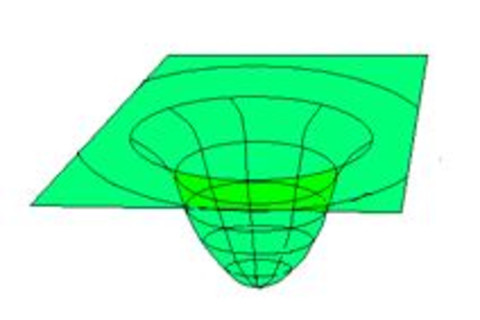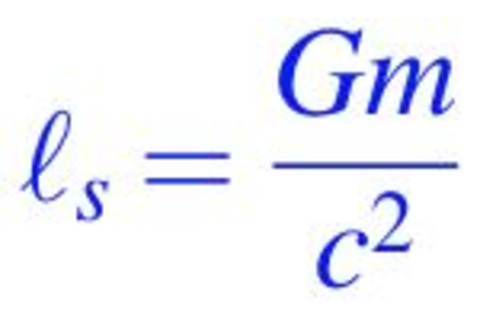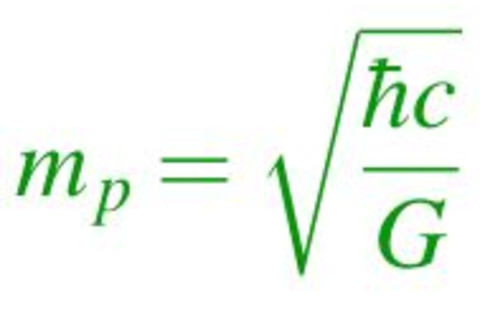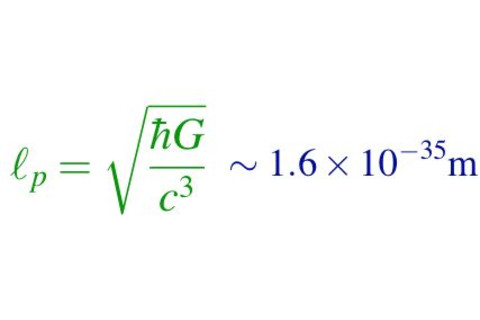The iPod Planck In the comment thread of a recent post on the iPod Nano, there was discussion of the practice of borrowing terms from physics and other sciences to make a product more attractive. Responding to various humourous suggestions of other names they may use upon further miniaturization, such as the iPod Femto or the iPod Atto (suggested by Joe Bolte), I suggested:
clearly they are moving toward the "ipod Planck", which would be the smallest ipod possible (while still being recognizable as an ipod). Also, the number of songs it will be able to store will be limited by its surface area, and not its volume.
Not missing a chance for a tortured link between topics, or a chance to write a gratuitously long post explaining some contemporary physics concepts, while apologizing for the geekiness of the (not very funny) joke, I offered to explain it if anyone asked. Someone decided to humour me (thanks "astromcnaught"), and so - in the words and accent of that excellent character Edna Mode in The Incredibles - Here. We. Are. Ok. I'm going to do this by unpacking each line, so let's take it from the top.
clearly they are moving toward the "ipod Planck", which would be the smallest ipod possible...
What I'm doing here is invoking the idea of the Planck scale. What is that?, you might ask. Good question. It is the length scale at which Quantum Gravity effects are supposed to be important.

Here's the quickest way I know to arrive at what it is intuitively and quantitatively. In quantum physics, an object of a given mass, m, has a characteristic length scale associated with it called its Compton wavelength. It involves two fundamental constants of nature, Planck's constant (hbar), and the speed of light (c). Since hbar is an extremely small number compared to c and your typical mass, this is why everyday macroscopic objects behave very classically - the scale at which quantum effects become important is really tiny compared to them. In other words, if you did an experiment that involved your object of mass m effectively with physics of about that sort of length scale (e.g. if the object itself is of roughly that size), the classical "billiard-ball" reasoning that we use for everyday things would be spectacularly wrong: Quantum effects would be important. Notice also that the larger m is, the smaller this Compton wavelength is. This is important, since roughly it tells us that small masses (electrons and the like) are more likely to see quantum effects than large ones.

In the realm of gravity, you've probably heard about Einstein's description of gravity as something to do with the geometry of spacetime. More massive objects warp spacetime more than less massive ones, etc. When you approach things this way, you find that Newton's gravity is just an approximation to this more fundamental formulation of the physics of gravity. If you don't use Einstein's picture, you'll get things wrong in many applications. (These are not just "out there" applications to astronomy and cosmology: Your GPS navigation system uses it too. But we've spoken of this before.) So, thinking like a good physicist, you can ask something analogous to the quantum situation. Given a mass m, what is the length scale beyond which (relativistic) gravity effects cannot be ignored?

This "Schwarzschild" scale (I can't think of a better name right now) involves two fundamental constants of Nature, the speed of light again, and Newton's gravitational constant, G, which is also a very small number. So in fact, most everyday objects and physics lies well above this scale, just like most everyday objects and physics lies well above the scale of quantum physics. If, however, you did an experiment that involved your object of mass m effectively with physics of about that sort of length scale (e.g. if the object itself is of roughly that size), the classical "Newtonian gravity" reasoning that we use for everyday things would be spectacularly wrong: Relativistic effects would be important - compressing an object of a given mass so much that its size is comparable to its Schwarzschild length would make it form a black hole, for example. Notice that the larger m is, the larger this Schwarzschild length scale is, which is important because it tells us, roughly, that large masses are more likely to see relativistic gravity effects than everyday objects (hence the study of stellar or multi-stellar mass black holes in astrophysical contexts). The key point to take away from all of this is that a given mass has those particular length scales associated to it, given by the formula. A different mass has new length scales associated with it, and you just use the formulae to compute them. Try computing your Compton wavelength and your Schwarzschild length, if you like. Everyday masses like ours make us "medium": given our physical dimensions (say, of the order of a meter) we are too massive for quantum to be relevant, not massive enough for relativistic gravity to be relevant.

You'll recall that the typically small quantum scale shrinks with mass, and the gravity scale grows with mass. So, like the good theoretical physicists you all are, you immediately ask the question. "Dude! What if, by choosing the mass carefully, you can make the scale of quantum effects and the scale of general relativistic effects coincide?!" Well, that is in fact a brilliant suggestion. You can compute the Planck length scale (as it is called) yourself: Just equate the two lengths in each formula and it gives you a formula for the mass that will do the trick*1. Then put that into one of the formulae for the lengths, and lo and behold, you have a formula for the Planck length in terms of the fundamental constants of Nature, hbar, c, and G. If you put those numbers in (note that this is a very four dimensional computation, but never mind) you find that the length is very very small.

About 10^(-35) metres. That's a decimal point and then 34 zeros before the actual significant numbers (1 and 6) show up. Note that an atom is about 10^(-10) across - humongously huge by comparison. The Planck scale thus computed is the naive result for the scale where both quantum and gravity physics matter: The scale of quantum gravity*2. So that's the first part of the joke. It would be a very small iPod indeed. But I did not stop there:
...which would be the smallest ipod possible (while still being recognizable as an ipod...
Well, there are several references in here. One is as follows: If the the Planck scale is where gravity is now behaving quantum mechanically, then we should not expect that its classical behaviour -nice smooth spacetime being gently curved by mass/energy- is accurate anymore, when doing physics at that scale. We know this is true for the quantum physics of other things. The electrons making the electronics in your mobile phone work cannot be treated as little particles following little paths through the circuits -the way we think classically. No. They are very quantum, and the idea of smooth paths, etc, that they follow -their whole identity as a particle- is just wrong. So (we expect*3) the same for spacetime and everything in it when you're down at the Planck scale. Hence the phrase "while still being recognizable as an ipod". The "smallest ipod possible" part comes from the fact that it is believed that the Planck scale is the ultimately smallest scale. This has been seen to arise in several applications of String Theory (largely due to something called T-duality", and its cousins), and also in other approaches to quantum gravity such as Loop Quantum Gravity. Another way of intuitively seeing that this might come about is the fact that we use geometry to measure and make sense of lengths. If geometry itself breaks down (as it is a classical concept) at the Planck scale, then there's no smaller lengths to make sense of, by definition. Ok. What next?
Also, the number of songs it will be able to store will be limited by its surface area, and not its volume.
Actually, I don't mind admitting that I'm still giggling at this. I have the capacity to make up stupid stuff and giggle at it at will. It's probably a sign of madness. Hey, it keeps me happy! So this refers to something called the "Holographic Principle". This actually ought to be called the "Holographic Expectation", since while it is a precise statement of physics, how it is realized varies from situation to situation. The basic statement is that while you may have thought that the limit to the amount of information that can be stored in a given region of spacetime is set by the volume of that region (i.e. how much spacetime there is inside), it is in fact set by the area of the boundary of that region. So imagine ball - like a beachball or such object. It defines a region of three dimensional space, given by the inside of the ball. This has some specific volume. The boundary of the region is the surface of the ball which is two dimensional, and so has a specific area. The Holographic Expectation is that the maximum amount of information (telling you e.g. about clumps of particles, what they are made of, how they are arranged, how they are interacting, etc) that you can pack into that ball is not set by the volume of the ball, but the area of its surface. This is an unexpected outcome of applying quantum physics to gravity, and first began to emerge in the early 1970s in the ideas of Bekenstein, while studying the results of Hawking arising from the study of quantum fields in the vicinity of black holes, and the classical laws of black hole mechanics developed by Hawking and others. The point is that a black hole acts like a thermodynamic object when you treat it properly. Its information content is given by its entropy, and this was seen to be proportional to the area of the black hole's horizon (the two dimensional boundary of the region containing the three dimensional black hole). The idea is that whatever information (say in the sense given above) falls into a black hole, it just makes the hole larger, increasing its area and hence its entropy by just the right amount. So a black hole tells us that its information content is (in a sense) determined by its boundary, not in its volume. So maybe black holes are just special, and not everything else does this? Not if you follow it through. Start in any part of spacetime and start to probe deeply to see what the possible information content is. The idea is that as soon as you do this effectively, you'll create a situation where you compress the information (and associated energy) in question into a small enough region of space that it will gravitationally collapse and form a black hole, for which we know the answer. So the "Holographic Expectation" seems to be a generic property of any theory of quantum gravity, and hence gets elevated to the "Holographic Principle", and in recent times was emphasized by t'Hooft, and then by Susskind in the context of string theory. (You can find references to Bekenstein and Hawking in those papers, and a big review paper here.) Now, we have a number of very well understood examples of it in string theory, such as the AdS/CFT correspondence, Matrix Theory, and Matrix Models, and apparently (although I am not qualified to say anything about it) those working in Loop Quantum Gravity also see it naturally arising in their approach to quantum gravity. Why the name "Holographic"? Well, it is a bit like what happens in optics to make those holograms that you see a lot in advertising and toys. They are two dimensional objects which (by clever storage of inteference data) can store and reproduce the appearance of three dimensional objects. In the quantum gravity context, the three dimensional physics is realized two dimensionally. It has led the field to wonder if our entire four (i.e., 3+1) dimensional description of our universe is redundant in some sense, and we need only work in one dimension fewer, but nobody has yet figured out the whole story yet. We've probably to wait for better grasp of our formulations of quantum gravity before we can address that. I've also spoken a lot about that on this blog, for example in the comment stream of this post on the Landscape. So I hope that explains the last part of the joke. Apple loves talking about how many songs you can get on your iPod. So that's information. So the iPod Planck (which is really really small - in fact, as small as possible) will naturally have its song capacity storage limit set by its area, and not its volume, due to the Holographic Principle. Are you rolling on the floor now? -cvj Footnotes: (*1: Actually, the Planck mass is about 10^(-8) kg, which is not unimaginably small. That's about the mass of a bacterium, but -as I love to say in my colloquia on the subject- that does not mean that that we should turn to the Biologists to help us do Quantum Gravity, nor can we expect any help from the NIH if we write a grant application...) (*2: I should note here that in string theory and related scenarios, there are ways of making that scale a lot larger, hence suggesting that Nature may have found ways of making quatum gravity more exxperimentally accessible. This has been talked about on this blog too.) (*3: Now we -meaning pretty much everyone working in this area of theoretical physics (i.e. not just those whacky string theorists)- could well be wrong about this. Maybe gravity and spacetime are an exception in some way. Quantum gravity ideas have not yet been experimentally tested, so Nature could just have decided to do something different. This is why research carries on.) [Update: Thanks Joe Bolte for pointing out some sloppy wording in an earlier version of this, and to erc for pointing out my typo in the esimate of the planck mass.]













